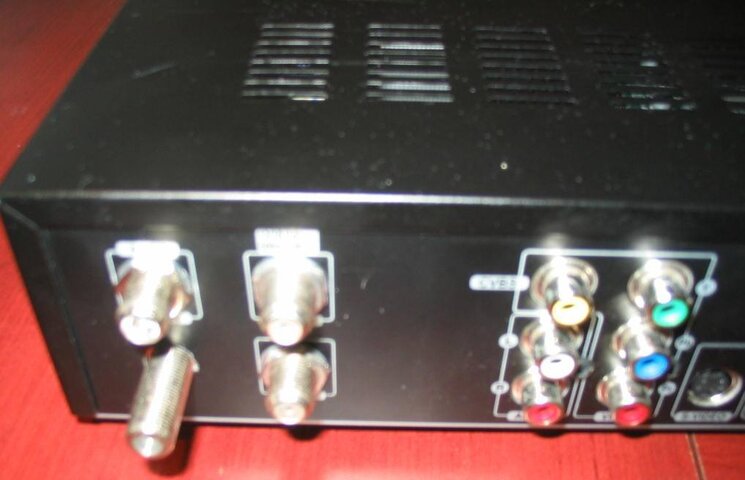I started this thread, as more and more used out of warranty SV HD receivers are getting sold for a lot less on EBay, Craiglist and such, and new owners can do easy mods described below to expand the STBs legit functionality and extend trouble free lifespan. Anyone with good links or suggestions is invited to join. Remember, its illegal to try using this nice HD receiver to decrypt encrypted signals, if at all possible, but completely legal to use it for clear channels viewing. 
Recently I came across a used Sonicview 8000HD receiver to play with for some time, until another interesting cheapi comes alone. First thing I did was clearing up its memory from whatever was their before and loading legit factory software to it. When I then looked under the hood, I found that its internal ATSC integrated NIM tuner is made by Samsung, specs of which are given here. This tuner is also capable of decoding NTSC and Clear QAM Cable signals, but these its capabilities aren't used in Sonicview 8000HD. I found that the tuner has 2 ports: In and Loop Through Out, but in a standard receiver only ATSC In port protrudes through the receiver's back panel allowing to attach coax cable to it. Full of good intentions to fix this sudden "design deficiency", I removed all PCBs from the box, drilled a hole in its back panel for the Loop Out port, and ordered an extended non-standard F-connector on EBay to let this newly discovered port out of the box.
That's when the story began to unfold. The EBay Chinese store selling that connector confirmed shipping instantly... only to send me another email 2 weeks later saying they are out of stock on these connectors, but expect more at some unspecified happy-go-lucky hour. And instead...offered me a standard short F-connector plentiful everywhere. After some mulling of the issue and usual mumble-jumble that almost lost forever long F-connector was magically found, and I even received the shipment tracking number this time around. After waiting just a little more than a month, I finally got one in my mailbox...from Singapore.
The EBay Chinese store selling that connector confirmed shipping instantly... only to send me another email 2 weeks later saying they are out of stock on these connectors, but expect more at some unspecified happy-go-lucky hour. And instead...offered me a standard short F-connector plentiful everywhere. After some mulling of the issue and usual mumble-jumble that almost lost forever long F-connector was magically found, and I even received the shipment tracking number this time around. After waiting just a little more than a month, I finally got one in my mailbox...from Singapore. 
Now it was time to check my Sonicview ATSC Tuner ports performance! I connected the extended F-connector to its hidden Loop Out port, mounted all PCBs back into the receiver's case, closed the cover, hooked up coax cable to the new port, switched the STB and my second TV On, and...vu a la. A strong signal appeared on my second HDTV. The Loop Out port is not powered, it passes through signal beautifully regardless of Sonicview being hooked to a power outlet or not. I scanned OTA channels, and got the same channels showing up on both Sonicview connected TV and my other HDTV with an integrated ATSC tuner. The list of OTA channels scanned was the same, regardless whether I hooked a coax to SW ATSC Loop Out port or not, so signal loss on the Loop Out is negligible. Great! Now I don't need to buy an expensive OTA Pre-amp and a set of splitters to get OTA channels showing up on our new HDTV in the bedroom! :sob:
Recently I came across a used Sonicview 8000HD receiver to play with for some time, until another interesting cheapi comes alone. First thing I did was clearing up its memory from whatever was their before and loading legit factory software to it. When I then looked under the hood, I found that its internal ATSC integrated NIM tuner is made by Samsung, specs of which are given here. This tuner is also capable of decoding NTSC and Clear QAM Cable signals, but these its capabilities aren't used in Sonicview 8000HD. I found that the tuner has 2 ports: In and Loop Through Out, but in a standard receiver only ATSC In port protrudes through the receiver's back panel allowing to attach coax cable to it. Full of good intentions to fix this sudden "design deficiency", I removed all PCBs from the box, drilled a hole in its back panel for the Loop Out port, and ordered an extended non-standard F-connector on EBay to let this newly discovered port out of the box.
That's when the story began to unfold.
Now it was time to check my Sonicview ATSC Tuner ports performance! I connected the extended F-connector to its hidden Loop Out port, mounted all PCBs back into the receiver's case, closed the cover, hooked up coax cable to the new port, switched the STB and my second TV On, and...vu a la. A strong signal appeared on my second HDTV. The Loop Out port is not powered, it passes through signal beautifully regardless of Sonicview being hooked to a power outlet or not. I scanned OTA channels, and got the same channels showing up on both Sonicview connected TV and my other HDTV with an integrated ATSC tuner. The list of OTA channels scanned was the same, regardless whether I hooked a coax to SW ATSC Loop Out port or not, so signal loss on the Loop Out is negligible. Great! Now I don't need to buy an expensive OTA Pre-amp and a set of splitters to get OTA channels showing up on our new HDTV in the bedroom! :sob:
Attachments
Last edited:











